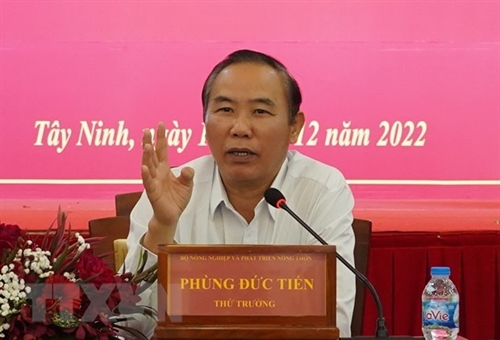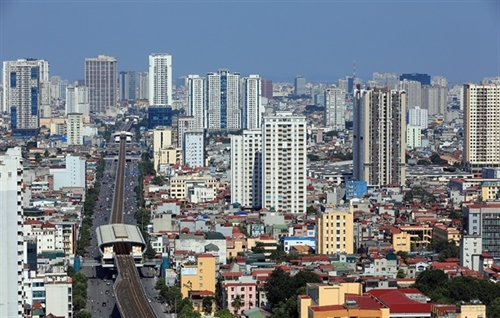Ramla Al Khalidi, United Nations Development Program (UNDP) Resident Representative in Vietnam, speaks to the Vietnam News Agency’s Việt Nam News about the challenges that Vietnam faces in biodiversity conservation as well as activities UNDP has been doing to help promote biodiversity conservation in the country.
The question-and-answer piece is conducted on the occasion of the 15th meeting of the Conference of the Parties to the Convention on Biological Diversity (COP15), which took place on December 7-19, 2022, in Montreal, Canada.
 |
A wild elephant herd in Yok Don national park (Dak Lak province) __Photo: VNA |
| A wild elephant herd in Yok Don national park (Dak Lak province) __Photo: VNA |
How do you assess the current situation of biodiversity in Vietnam? What are the challenges facing Vietnam in biodiversity conservation?
The natural world is at a breaking point, plagued by the two biggest existential crises in our lifetime: biodiversity loss and climate change. With the COP15 taking place in Montreal, Canada, the world looks back with deep regret and serious concern that not one of the 20 targets set at Aichi, Japan, back in 2010 during COP10, has been fulfilled.
Vietnam, unfortunately, shares a similar trend in biodiversity degradation as with many parts of the world, with an increasing number of threatened species, and degraded ecosystems of forests, wetlands and marine areas, among other issues.
Reports have shown that the number of threatened species in Vietnam has risen sharply in recent years, and for several species, time has already run out and they have become extinct, including the Javan rhinoceros and the Giant ibis. In addition, the Indochinese tiger is considered functionally extinct, with other large mammal species such as the Asian elephant, many big cats (Felidae spp.), bears (Ursus spp.), pangolins (Manis spp.) not far behind.
The first National Ecosystem Assessment Report by the Ministry of Natural Resources and Environment (MONRE) has shown that over the past two decades, the area of seagrass has decreased by 45.4 percent and the average annual reduction rate was 4.4 percent. The live coral cover of coral reefs in coastal areas is decreasing rapidly over time. Only about 1 percent of the reefs have a high coverage while the number of reefs with low coverage reefs accounts for over 31 percent, and the rest is for medium to slight coverage coral reefs. For terrestrial forests, while the overall forest coverage is reported to remain at roughly 42 percent, deforestation and forest degradation are still rampant, with biodiversity-rich natural forests being replaced with monoculture forests that have little to no biodiversity values.
Vietnam is among the top 16 countries and territories with the richest biodiversity of global significance. Recognizing the importance of biodiversity and ecosystem services for sustainable economic development, the Government has made significant efforts to protect biodiversity, including the introduction of legal frameworks and the establishment of protected areas systems.
However, Vietnam faces several challenges that could make it more difficult to halt and reverse the downward trends of biodiversity loss.
First of all, while Vietnam has developed a relatively comprehensive legal framework for environmental protection and biodiversity conservation, including the latest Law on Environmental Protection of 2020, the enforcement of the laws and sub-laws is still low due to many reasons, including unclear division of responsibilities among ministries and agencies, low-deterrence penalty schemes, insufficient capacity and low commitment on the part of central and local decision-makers.
Second, it is necessary for Vietnam to transform its business-as-usual development modality into a more sustainable, resource-efficient, and nature-positive one. Examples of business-as-usual development include overexploitation of natural resources and overconsumption. Overfishing and destructive fishing methods have resulted in destroyed or depleted natural ecosystems. Also, over-and-unsustainable tourism causes negative impacts on biodiversity from direct tourists’ sightseeing activities, infrastructure-related developments, and pollution.
Last, being one of the countries most vulnerable to climate change puts more pressure on the already vulnerable ecosystems in Vietnam and hinders the national efforts in reversing the biodiversity declination trend. For example, the increase in average temperature will change many ecosystems’ geographic distribution and population structure and exacerbate other threats such as forest fires, droughts and tropical storms.
Could you please suggest some solutions to promote biodiversity conservation in Vietnam?
While much needs to be done to overcome the first challenge of ineffective law enforcement, we believe one of the keys is that mainstreaming biodiversity conservation in all sectors may be done more systematically and effectively. For instance, socio-economic development indicators should be more biodiversity-specific. The current indicator of “area of forest coverage” does not tell us the quality of forests or their biodiversity levels. We could learn from the achievement of climate change mainstreaming in Vietnam, where climate mitigation and adaptation are quite systematically incorporated in socio-economic development master plans and plans across many sectors. We need the same, if not more, awareness of and commitment to biodiversity conservation.
Transforming the country’s business-as-usual development modality into a more sustainable, resource-efficient, and nature-positive one shall help Vietnam take the leap in biodiversity and nature conservation. Our recommendations include materializing the targets of the Green Growth Strategy by embracing better the circular economy model, in which sustainable natural resource exploitation, resource-efficient production and moderate consumption will be put at the center.
The system of protected areas (PA) in Vietnam needs to be improved in both quantity and quality. Comprehensive planning, capacity building and financial allocation for PA management should be prioritized in the biodiversity agendas. Most financing allocated for PAs has not been prioritized for biodiversity conservation work itself. Therefore, in the coming time, apart from financial mobilization from the international community, the Government needs to allocate more budgets for biodiversity conservation.
Indigenous and local communities are often the best guardians of forests and natural ecosystems, where successive generations call home. At the same time, local communities often face disproportionate impacts of biodiversity loss given the interdependence of health environments that crucially underpin their lives and livelihoods. Therefore, ensuring indigenous and local people’s voices in the debate on biodiversity conservation and improvement of livelihoods will help preserve traditional knowledge in conserving nature and reduce the pressure on the environment.
The Government of Vietnam has made commendable efforts in improving the well-being of ethnic minority people and other vulnerable groups through poverty reduction and social protection programs, and in the context of increased threats from climate change and biodiversity loss, this should be continually put at the center of the Government’s development agendas.
What is the link between biodiversity and climate change? How does biodiversity impact climate change and vice versa?
Climate change and biodiversity are interconnected. Climate change drives biodiversity loss, and in return, ecosystem degradation exacerbates climate change. For example, sea level rise would severely affect 78 out of 286 critical habitats (equivalent to 27 percent), 46 PAs (to 33 percent), nine biodiversity areas of national and international value (23 percent), and 23 other biodiversity areas in Vietnam, according to MONRE’s Report. Loss of biodiversity and degraded ecosystems also accelerate climate change processes due to the reduced capacity of ecosystems to assimilate and store CO2 as well as the loss of critical barriers reducing sea level rise’s impacts (e.g., mangrove forests).
In contrast, biodiversity resources can help mitigate the impacts of climate change and allow for climate adaptation. In terms of mitigation, trees and sea water are silent heroes in CO2 sequestration. In other words, their natural mechanisms help absorb and store carbon naturally, thus relieving gas emissions in the atmosphere.
Nonetheless, it’s important to not over-rely on sea water for carbon sequestration since CO2 excess can impact marine life for many species. For adaptation, coral reefs and mangroves are the nature’s incredible endowed assets that can shield the coast against inundation and protect vulnerable communities most affected by the risk of catastrophic sea level rise and its aftermath. Since these natural resources are on the decline, restoring and conserving them will aid the world’s collective fight for our survival against climate change.
Which activities has UNDP been doing to help promote biodiversity conservation in Vietnam?
The UNDP has been doing a lot of projects and programs to promote nature and biodiversity conservation in Vietnam.
We have supported the establishment of Thai Thuy Wetland PA in Thai Binh province and Tam Giang-Cau Hai Wetland PA in Thua Thien Hue province, together with formulating and promulgating policies, regulations and planning frameworks for wetland conservation (Decree 66 of 2019) and supporting the integration of wetland conservation and management into the plans of the two provinces. This contributes to Vietnam’s continued efforts in expanding PA, as set forth in the new National Biodiversity Strategy through 2030, with a vision toward 2050.
We have been supporting the strengthening of the legal framework and management of Biosphere Reserves (BR) in Vietnam through the BR project, which sets out to promote interdisciplinary management of BRs, facilitate the conservation of ecosystems in Cu Lao Cham-Hoi An, Dong Nai, Western Nghe An BRs, and foster local livelihoods, through improved legal and institutional frameworks, with interdisciplinary actions on the ground to deliver the restoration and better management of degraded forest land, and improvement of economic livelihoods for local households.
Our upcoming nature-based tourism project will aim to promote responsible ecotourism in National Parks (NP) in Vietnam through effective public-private partnership between NPs and tourism operators and identified mechanism to channel more tourism revenues to fund biodiversity conservation at NPs. This project is one of the efforts to tackle over-and-unsustainable tourism in Vietnam, which is one of the main drivers for biodiversity loss in the country.
In addition, the UNDP has been working under the Biodiversity Finance Initiative (BIOFIN) to pilot several financial solutions, including Payment for Ecosystem Services, marine resource protection fee to mobilize more funding for PAs. Also, the BIOFIN project helps preparation of fundamental reports for identifying increased biodiversity finance including the Biodiversity Finance Plan for Vietnam.
We are working on developing projects that aim to deliver innovative nature-based solutions that contribute to the restoration of degraded ecosystems along major river basins and coastal areas. Nature-based solutions are giving us high hopes in achieving dual/triple targets in ecosystem restoration and climate change mitigation and adaptation.









